Master Data Collection in IoT: Best Practices for Analysts
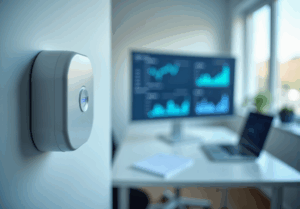
Master Data Collection in IoT: Best Practices for Analysts
Overview
The article emphasizes best practices for data collection in the Internet of Things (IoT), highlighting the significance of identifying data types and sources, implementing effective methodologies, ensuring data quality, and analyzing collected data for actionable insights. It details various data types, such as sensor data and user-generated information, alongside methodologies like automated data collection and real-time streaming. These features enhance the reliability and depth of IoT analytics, ultimately driving informed decision-making.
Why is it crucial to understand the types of data available? Recognizing the variety of data sources allows organizations to leverage the most relevant information for their needs. For instance, sensor data provides real-time insights into environmental conditions, while user-generated information can reveal consumer preferences and behaviors. By employing methodologies that facilitate efficient data collection, organizations can ensure the quality of their data, leading to more accurate analyses.
In conclusion, the effective collection and analysis of IoT data empower organizations to make informed decisions. By adopting these best practices, businesses can enhance their analytical capabilities, ultimately leading to improved outcomes and strategic advantages in a data-driven landscape.
Introduction
In an increasingly interconnected world, the Internet of Things (IoT) generates vast amounts of data that have the potential to transform industries. For analysts, mastering data collection in IoT is not merely a technical task; it represents a critical opportunity to harness insights that drive strategic decisions.
However, navigating the complexities of diverse data types, sources, and methodologies poses significant challenges. How can professionals ensure they are collecting the right information to unlock the true value of IoT analytics?
This question underscores the importance of a strategic approach to data collection, highlighting the need for clarity and precision in gathering insights that can inform decision-making.
Identify Data Types and Sources in IoT
In the realm of IoT, data collection in IoT allows information to be categorized into structured, unstructured, and semi-structured types. Analysts should prioritize identifying specific data types relevant to their projects, including:
- Sensor Data: Information collected from devices such as temperature sensors, motion detectors, and smart meters, which provides real-time insights into operational conditions.
- User-Generated Information: Information produced by users interacting with IoT devices, including app usage statistics and feedback, which can inform user experience improvements.
- Environmental Data: Data related to external conditions, such as weather patterns or geographical information, essential for contextualizing IoT applications.
Key sources of data include:
- IoT Devices: The primary source of real-time data, crucial for monitoring and control.
- APIs: Application Programming Interfaces that enable information exchange between systems, facilitating integration and interoperability. SavvyIQ's AI-driven APIs, backed by the exclusive Recursive Information Engine, improve this process by delivering enriched business identity and intelligence insights, enabling analysts to make informed choices.
- Third-Party Information Providers: Organizations that offer datasets complementing IoT information, enhancing analytical capabilities. SavvyIQ stands out as a provider of high-quality datasets that can significantly improve the depth of analysis.
Statistics indicate that structured information constitutes approximately 20% of the total content generated in IoT environments, while unstructured information comprises about 80%. This emphasizes the significance of concentrating on both information types for thorough analysis.
Expert Matt Hatton emphasizes, "Companies looking to procure connectivity for IoT devices could save on average 28 percent by using a ‘Hyperscale IoT Connectivity’ solution where compliance, security, and cloud optimization are standard features." This highlights the importance of efficient information management in IoT analytics.
Successful instances of information categorization in IoT projects include smart city initiatives that utilize environmental insights to optimize traffic flow and reduce energy usage. By thoroughly recognizing these information types and origins, professionals can ensure that data collection in IoT gathers the most pertinent details to effectively achieve their goals. This organized method not only simplifies data collection in IoT but also enhances the overall quality of insights obtained from IoT analytics.
Nevertheless, evaluators should be mindful of typical traps, such as neglecting the incorporation of unstructured information sources or failing to account for the changing function of the IoT Connectivity Management Platform (CMP) in overseeing information flows. By tackling these challenges, researchers can enhance their information gathering methods and attain superior results.
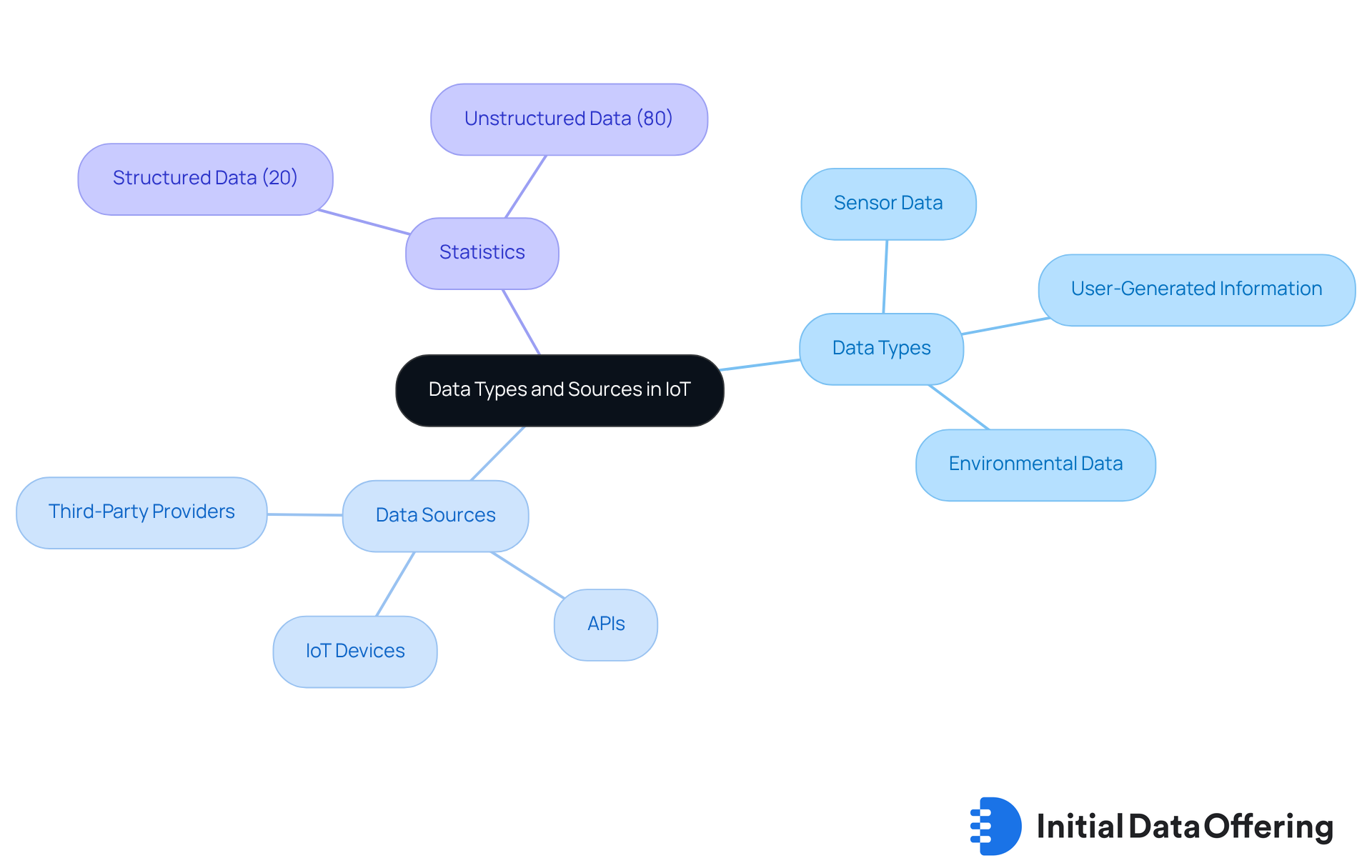
Implement Effective Data Collection Methodologies
To implement effective data collection in IoT, analysts should consider several key approaches that enhance the quality and reliability of their data.
-
Automated Data Collection: By utilizing IoT platforms that support automated data gathering, organizations can significantly minimize human error and increase efficiency. This feature not only streamlines the data collection process but also ensures that the information is accurate and timely. The advantage of automation lies in its ability to handle large volumes of data swiftly, providing researchers with a robust dataset for analysis.
-
Sampling Techniques: Employing suitable sampling methods, such as stratified sampling, is crucial for ensuring that the information gathered is representative of the larger population. This approach allows analysts to draw meaningful conclusions from their data, enhancing the validity of their findings. By carefully selecting samples, researchers can gain insights that are more reflective of real-world scenarios, ultimately benefiting their decision-making processes.
-
Real-Time Information Streaming: Utilizing technologies that permit real-time information streaming facilitates instant analysis and faster decision-making. This capability is particularly beneficial in dynamic environments where timely insights are critical. The advantage of real-time data is its ability to provide immediate context, allowing researchers to respond quickly to emerging trends or issues.
-
Information Integration: The use of integration tools to merge information from various sources ensures a comprehensive dataset that improves analysis. By combining data from disparate systems, analysts can uncover patterns and correlations that might otherwise go unnoticed. This holistic approach not only enhances the depth of analysis but also leads to more trustworthy insights.
By embracing these methodologies, researchers can significantly improve the efficiency and effectiveness of their information gathering efforts, resulting in insights that are both reliable and actionable. How might these strategies transform your own data collection processes?
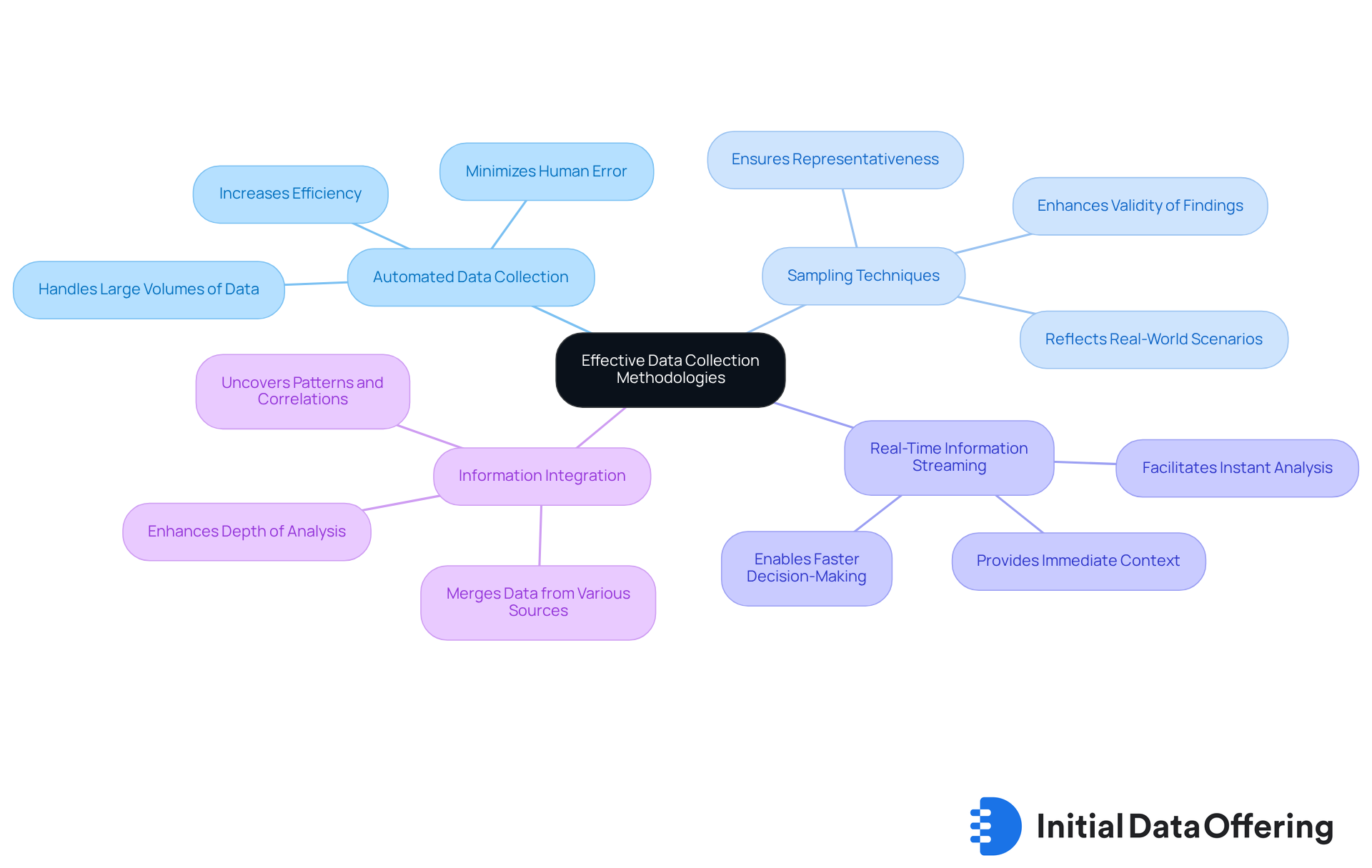
Ensure Data Quality and Integrity
To ensure data quality and integrity in IoT data collection, analysts should adopt several best practices that enhance their operational effectiveness:
-
Data Validation: Implement robust validation rules to verify the accuracy and completeness of data as it is collected. This step is essential, as inadequate information quality can result in considerable operational failures. Studies show that up to 85% of AI projects fail due to neglected information issues. As Sucheta Rathi pointed out, "With 95% of businesses acknowledging information quality as essential to their digital transformation initiatives, artificial intelligence (AI) is no longer an optional enhancement—it’s a mission-critical requirement."
-
Regular Audits: Conduct periodic evaluations of information collection processes to identify and rectify discrepancies or errors. Frequent evaluations assist in upholding a Data Quality Index (DQI) target of 90%, thereby improving evidence-based decision-making. The IoT Information Pipeline has demonstrated the effectiveness of regular audits in the context of data collection in IoT, resulting in a 13% improvement in accuracy in UNISFA.
-
Information Purification: Employ information purification methods to remove duplicates, rectify inaccuracies, and standardize formats. This practice is crucial for ensuring that the information used in analytics is reliable and actionable. The significance of upholding high-quality information practices is underscored by the statistic that 42% of AI projects failed in 2025 due to inadequate quality.
-
Documentation: Maintain comprehensive documentation of information sources, collection methods, and any transformations applied to the information. Clear documentation supports effective information stewardship, ensuring that every byte of information is managed according to established policies.
By prioritizing these practices, professionals can significantly enhance the reliability of their insights. This fosters greater confidence among stakeholders and drives informed decision-making across various sectors. How can your organization implement these best practices to improve data quality and integrity in data collection in IoT?
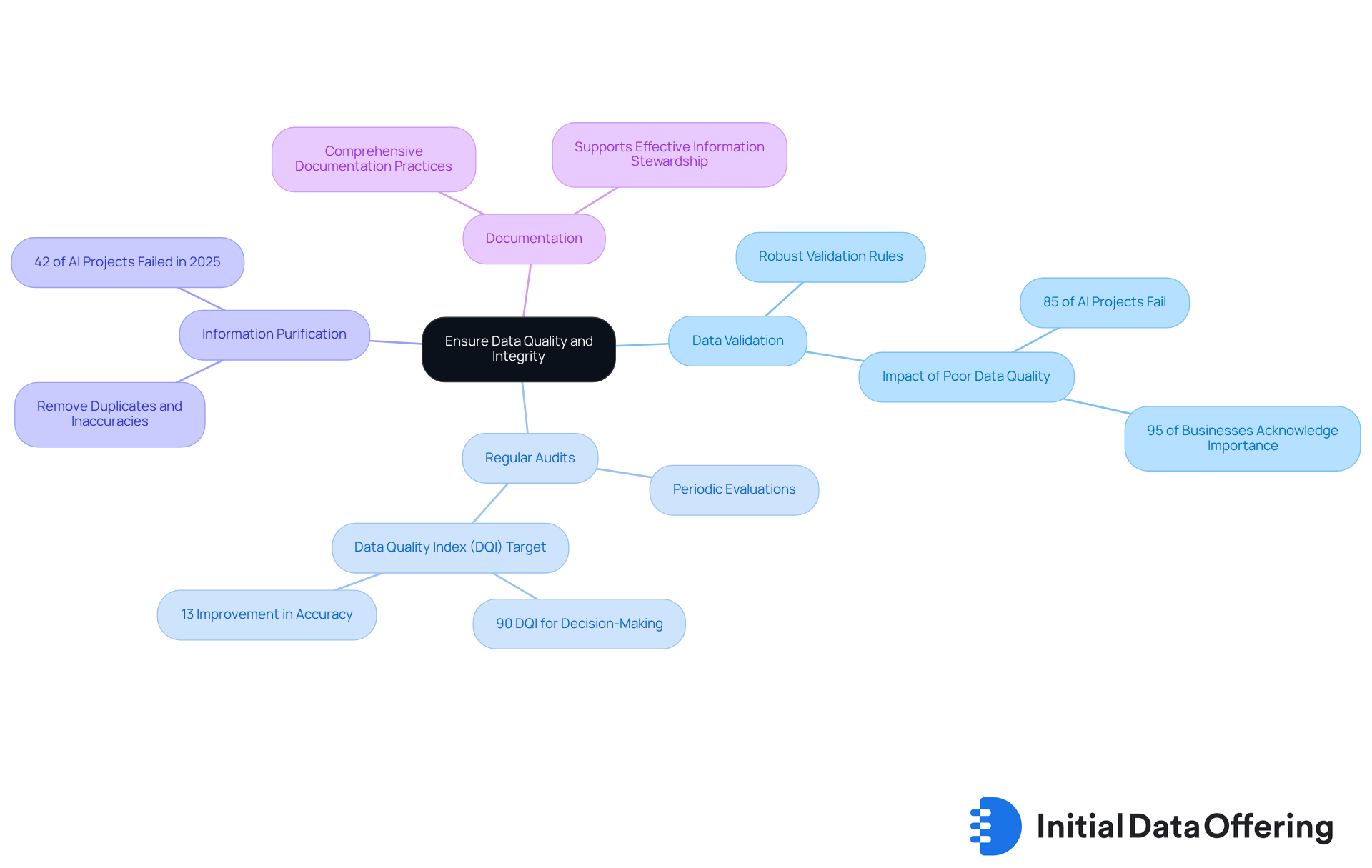
Analyze and Interpret Collected Data for Insights
Once information has been gathered and verified, analysts should prioritize the examination and interpretation of this information to extract actionable insights. Key practices include:
- Descriptive Analytics: This practice involves utilizing descriptive statistics to summarize historical IoT data effectively. By identifying trends and patterns, analysts can inform decision-making. This foundational step is crucial for understanding the historical context of the information.
- Predictive Analytics: Employing predictive modeling methods allows analysts to anticipate future trends based on historical information. This approach aids in anticipating market changes and enhances operational efficiency. For instance, industries like manufacturing have seen predictive maintenance reduce downtime by 30-50%, according to McKinsey.
- Information Visualization: Utilizing visualization tools helps display information in a readily understandable format. Effective visual representations promote clearer communication of findings to stakeholders, making intricate information more accessible and actionable.
- Feedback Loops: Establishing feedback mechanisms is essential for continuously enhancing information gathering and analysis processes. By integrating insights gained from previous analyses and emphasizing the necessity of continuous learning and adaptation, organizations can improve the accuracy of future predictions.
By effectively analyzing and interpreting the data collection in IoT, analysts can provide valuable insights that drive informed decision-making and strategic planning. This ultimately enhances the organization's ability to respond to market dynamics. For instance, DHL's use of IoT-enabled predictive analytics to optimize delivery routes has led to a reduction in logistics costs by up to 15%. This showcases the practical benefits of these analytical practices.
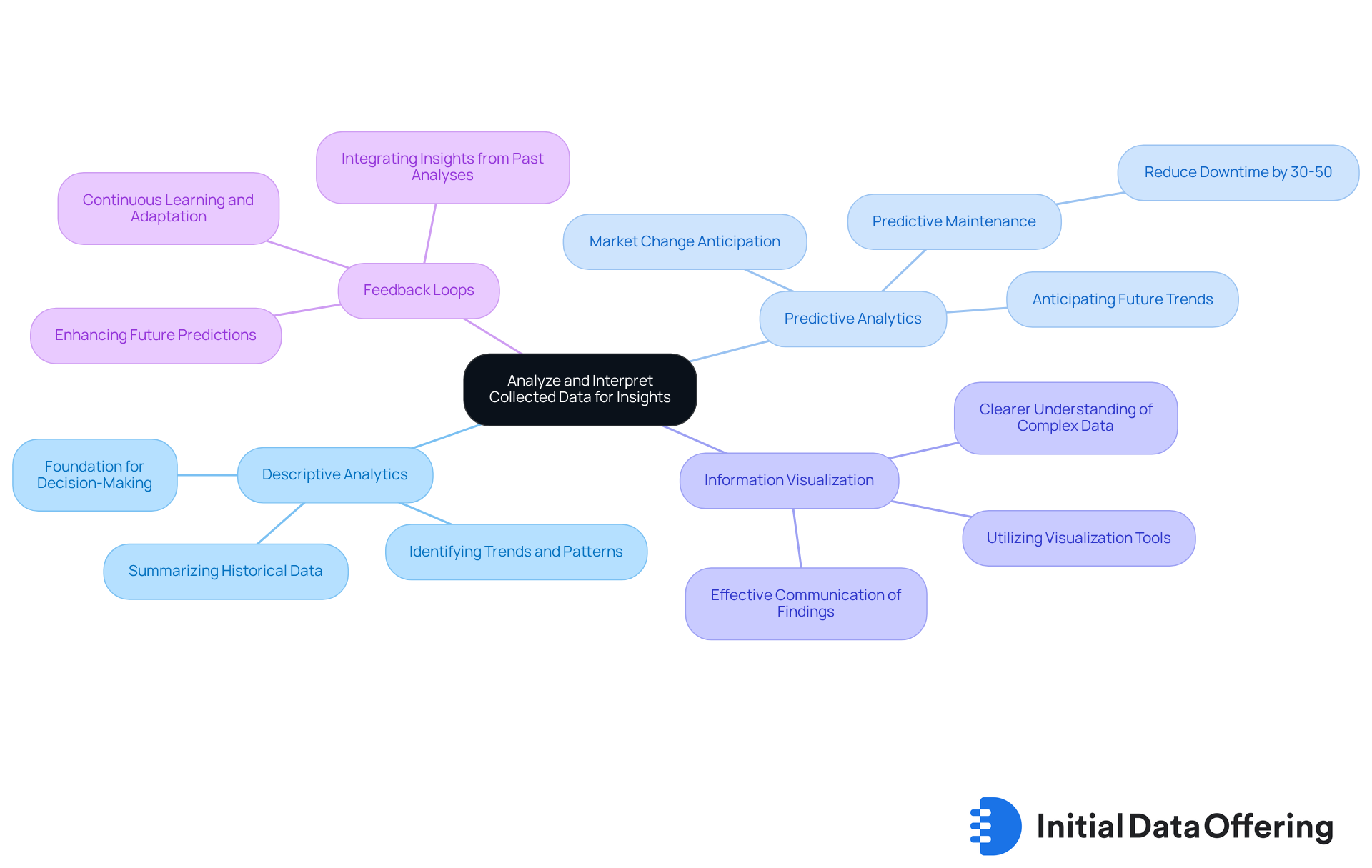
Conclusion
Mastering data collection in the Internet of Things (IoT) is essential for analysts aiming to harness the full potential of this technology. Understanding the various types of data and their sources, implementing effective methodologies, and ensuring data quality are key features that organizations must focus on. The advantages of this structured approach include enhanced analytical capabilities, leading to better insights that support informed decision-making and strategic planning. Ultimately, the benefits manifest as empowered stakeholders who can drive innovation and efficiency in a competitive landscape.
The article highlights several best practices, such as the importance of identifying structured and unstructured data. Utilizing automated data collection methods and maintaining data integrity through regular audits and validation are critical advantages. By leveraging real-time information streaming and robust integration techniques, analysts can create comprehensive datasets that reveal valuable patterns and insights. Furthermore, employing advanced analytical techniques like predictive modeling and effective visualization transforms raw data into actionable intelligence, illustrating how these practices can significantly improve outcomes.
The significance of effective data collection in IoT cannot be overstated. As organizations navigate the complexities of data management, embracing these best practices will not only improve data quality but also empower stakeholders to make informed decisions. How can your organization adopt a proactive approach to data collection and analysis? By doing so, it is possible to stay competitive in an increasingly data-driven landscape, ensuring that the insights derived from data contribute to strategic initiatives and operational excellence.
Frequently Asked Questions
What are the main types of data collected in IoT?
The main types of data collected in IoT include structured data, unstructured data, and semi-structured data. Specific examples are sensor data, user-generated information, and environmental data.
What is sensor data in the context of IoT?
Sensor data refers to information collected from devices such as temperature sensors, motion detectors, and smart meters, providing real-time insights into operational conditions.
What role does user-generated information play in IoT?
User-generated information is produced by users interacting with IoT devices, including app usage statistics and feedback, which can inform improvements in user experience.
Why is environmental data important for IoT applications?
Environmental data relates to external conditions, such as weather patterns or geographical information, which are essential for contextualizing IoT applications.
What are the key sources of data in IoT?
Key sources of data in IoT include IoT devices, APIs (Application Programming Interfaces), and third-party information providers.
How do APIs contribute to IoT data management?
APIs enable information exchange between systems, facilitating integration and interoperability. SavvyIQ's AI-driven APIs enhance this process by delivering enriched business identity and intelligence insights.
What is the significance of structured and unstructured data in IoT?
Statistics indicate that structured information constitutes about 20% of the total content generated in IoT environments, while unstructured information makes up approximately 80%. This highlights the importance of focusing on both types for comprehensive analysis.
What is a ‘Hyperscale IoT Connectivity’ solution?
A ‘Hyperscale IoT Connectivity’ solution is a connectivity option for IoT devices that can save companies an average of 28 percent by integrating compliance, security, and cloud optimization features.
Can you provide an example of successful data categorization in IoT?
Successful instances of information categorization in IoT projects include smart city initiatives that use environmental insights to optimize traffic flow and reduce energy usage.
What challenges should evaluators be aware of when collecting IoT data?
Evaluators should be mindful of challenges such as neglecting unstructured information sources and failing to account for the evolving role of the IoT Connectivity Management Platform (CMP) in overseeing information flows.